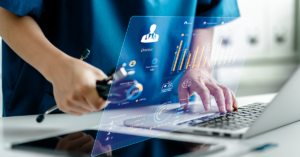We’re a little more than one week out from the annual HIMSS conference which begins on Monday, March 5 at the Sands Expo Center in Las Vegas, NV. The event brings together more than 40,000+ health IT professionals from various sectors of the industry. To help you better prepare for this whirlwind event, we connected with our very own Diane Gerdes, payer product marketing manager, to gather her predictions on what trends she believes will be top of mind for the payer industry and some major topics that will be discussed during the conference.
Here are Diane’s four predictions:
1. Increase in merger and acquisitions
The payer market continues to experience drastic change and game-changing mergers and acquisitions (like the CVS and Aetna merger) will continue to transform how the insurance market operates. Combining forces amongst major players will help bring a new perspective to the industry and allows for payers to differentiate themselves and remain competitive in a fast-moving space.
2. Rapid development of health apps and new data
Since the creation of smartphones and wearable technology – consumer-facing apps and data have boomed. In the United States, there are more than 200 million smartphone users with access to more than 4 million apps. In addition, a recent article in Managed Healthcare Executive reports that the wearable market is expected to grow from 101.9 million units sold in 2016 to 213 billion units in 2020. This is an incredibly large, untapped data pool that holds great promise for the healthcare industry – “smart” information that leads to smarter decisions. We can expect payers to employ more consumer-facing applications and devices to better understand and connect with their members across their healthcare journey.
3. Engaged healthcare consumers
Members are evolving and using various modalities to connect – not only with their friends or family but with their healthcare providers. While different age groups are adopting technology at varying rates, healthcare consumers overall are demanding more digital capabilities and greater access to information and services. According to a MobileSmith report, by 2020 millennials will make most of the healthcare decisions in the U.S. Given this shift, payers need to evolve their coverage plans to account for how these individuals receive care, including telehealth and remote monitoring (e.g., remote glucose monitors). These services not only offer convenient, affordable alternatives to traditional office visits but also deliver a constant stream of data. The ability to harness this information, along with other data, and transform it into meaningful, actionable insights will be key to delivering high-quality, patient-centric care.
4. New methods for data analysis
The volume of healthcare data is increasing at an exponential rate: 48 percent per year. To manage these growing data sets, sophisticated analytic tools and machine learning will become more important to identify patterns and predict outcomes. In fact, the role of machine learning in healthcare and clinical decision making are currently dominating news headlines. At MedeAnalytics, data discovery, data mapping, and statistical analysis (a key component of machine learning) helps us to show our customers what is needed for any given implementation. Our platform also uses linear regression models to learn trends based on our client’s trends. Transformative technologies, like AI and machine learning, will continue to play an increasingly important role in healthcare as they will help payer organizations to make more data-driven decisions.
2018 will be the year of the patient in healthcare and we can expect that theme to impact the way traditional healthcare payers operate.
If you’re interested in meeting with us at HIMSS, click here to schedule your appointment. Looking for more resources for the payer market? Check out our solutions page here.
Get our take on industry trends
Three ways to improve patient retention in recovery programs
Deaths from drug overdoses have increased from ~1 per 100,000 in 1999 to ~4 per 100,000 in 2020.1 The introduction…
Read on...ACOs and value-based care in 2024: Four key questions and answers
ACOs have long been at the front lines of value-based care efforts. In a recent LinkedIn Fireside Chat, Andy Dé…
Read on...How is telehealth impacting STARs performance?
STAR scores are a critical component of success for Medicare Advantage Plans, MSSP and REACH ACOs, driving them to maximize…
Read on...Brief introduction to contract administration
At the top of the year, Rahul Sharma, Chief Executive Officer, and Lynn Carroll, Chief Operating Officer and Cofounder of…
Read on...


